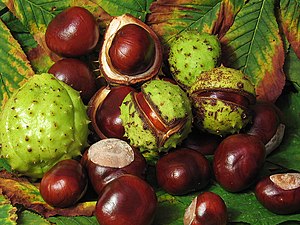Korean/Words/말밤*
Appearance
| This is a primary, secondary and/or original Eurasiatic research project at Wikiversity. |
| |
말밤*
[edit | edit source]

- Roman: mal-bam*
- Alias: *말밤 (assumed of sense)
- Hanja: 末栗 (literally "coarse chestnut" hence actually "horse chestnut")
- Noun
- 학명 Aesculus hippocastanum 의 한 고유/차입 번역어. [1]
- Synonyms
- 마로니에 (maronie, "horse chestnut") -- the loanword from French. [3]
- 서양칠엽수 (seoyang-chil-yeobsu, "horse chestnut") [4]
- 가시칠엽수 (gasi-chil-yeobsu) [5]
- 일본칠엽수 (ilbon-chil-yeovsu) Aesculus turbinata [6]
- Antonyms
- 단밤 (dan-bam, literally and actually "sweet chestnut") [7]
- 밤 (bam, "chestnut")
- Relatives
- 말밤 (mal-bam, "water caltrop, water chestnut") -- the etymon, now dialect.
- 마름 (mareum, "water caltrop, water chestnut") -- the corrupted, now canonized.
- 물밤 (mul-bam, "water caltrop, water chestnut") -- the dialect, conforming to "water chestnut."
- Comparatives
- Selected from horse chestnut #Translations
|
- References
- Lack, H. Walter. (2001). "The Discovery and Rediscovery of the Horse Chestnut." Arnoldia 61/4, pp. 15-19.
- ↑ Unauthorized, hence the asterisk.
- ↑ The prefix "horse" here means "coarse" rather than "large," as is the case with most other botanical compounds. Then, Latin hippo should also mean "coarse" as English "horse" does.
- ↑ This is implausibly imported, perhaps under the Japanese watering influence; instead, it would be plausible to reuse the native 말밤 which is not used canonically. Also noteworthy is the resemblance of marron to 마름 (mareum) stemming from 말밤.
- ↑ A mundane Sino-Korean harangue, contrasting to the Japanese as yin-yang, either-or.
- ↑ 열매는 밤과 닮았지만, 사포닌과 글루코사이드가 들어있는 등 약한 독성을 띄고 있어서 먹을 수 없다. Inedible, in short.
- ↑ Framing around Japan? By whom?
- ↑ The [ sweet chestnut ] tree is to be distinguished from the horse chestnut Aesculus hippocastanum, to which it is only distantly related. The horse chestnut bears similar looking seeds (conkers) in a similar seed case, which are not palatable to humans.
- ↑ Why is the qualifier "of India" used? To avoid using "horse"?
